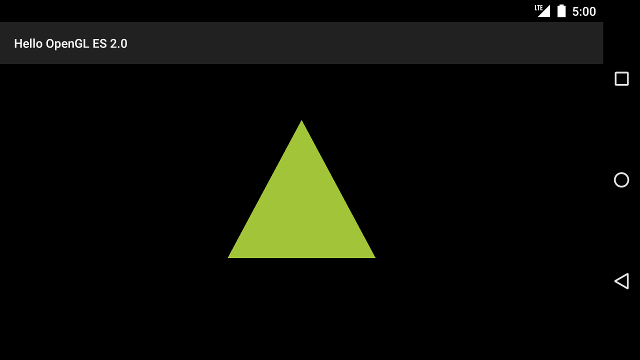在 OpenGL ES 环境中,投影和相机视图允许您以 更接近您用眼睛看实物的方式。这种模拟 实物观看是通过对绘制对象坐标进行数学转换完成的:
- 投影 - 这种转换可根据
GLSurfaceView的宽度和高度。不包含 通过该计算,OpenGL ES 绘制的对象会被不等比例的视图所扭曲 窗口。投影转换通常只有在 OpenGL 视图是在渲染程序的onSurfaceChanged()方法中建立或更改的。有关 OpenGL ES 投影和 坐标映射, 请参阅 映射所绘制的坐标 对象。 - 相机视图 - 这种转换可根据
虚拟摄像头的位置。请务必注意,OpenGL ES 不会定义实际的相机
对象,而是提供了实用程序方法,通过将
绘制的对象。相机视图转换可能只计算一次,
GLSurfaceView,也可以根据用户操作或您的 应用的功能。
本课介绍如何创建投影和相机视图,并将其应用于
您的GLSurfaceView。
定义映射
投影转换的数据在 onSurfaceChanged() 中计算得出
方法中 GLSurfaceView.Renderer 类的构造函数。以下示例代码
接受 GLSurfaceView 的高度和宽度,并使用它来填充
投影转换 Matrix(使用 Matrix.frustumM() 方法):
Kotlin
// vPMatrix is an abbreviation for "Model View Projection Matrix" private val vPMatrix = FloatArray(16) private val projectionMatrix = FloatArray(16) private val viewMatrix = FloatArray(16) override fun onSurfaceChanged(unused: GL10, width: Int, height: Int) { GLES20.glViewport(0, 0, width, height) val ratio: Float = width.toFloat() / height.toFloat() // this projection matrix is applied to object coordinates // in the onDrawFrame() method Matrix.frustumM(projectionMatrix, 0, -ratio, ratio, -1f, 1f, 3f, 7f) }
Java
// vPMatrix is an abbreviation for "Model View Projection Matrix" private final float[] vPMatrix = new float[16]; private final float[] projectionMatrix = new float[16]; private final float[] viewMatrix = new float[16]; @Override public void onSurfaceChanged(GL10 unused, int width, int height) { GLES20.glViewport(0, 0, width, height); float ratio = (float) width / height; // this projection matrix is applied to object coordinates // in the onDrawFrame() method Matrix.frustumM(projectionMatrix, 0, -ratio, ratio, -1, 1, 3, 7); }
此代码会填充投影矩阵 mProjectionMatrix,然后您可以将该矩阵合并
并在 onDrawFrame() 方法中实现相机视图转换,这在下一节中将有所说明。
注意:只需将投影转换应用于 绘制对象通常会导致显示画面很空。一般来说,您还必须将相机 视图转换,以便在屏幕上显示任何内容。
定义相机视图
通过添加镜头视图转换函数来完成绘制对象的转换过程,如下所示
绘制程序的一部分在下面的示例代码中,相机视图
转换是使用 Matrix.setLookAtM() 计算的
方法,然后将该矩阵与之前计算的投影矩阵合并。组合
然后将转换矩阵传递给所绘制的形状。
Kotlin
override fun onDrawFrame(unused: GL10) { ... // Set the camera position (View matrix) Matrix.setLookAtM(viewMatrix, 0, 0f, 0f, 3f, 0f, 0f, 0f, 0f, 1.0f, 0.0f) // Calculate the projection and view transformation Matrix.multiplyMM(vPMatrix, 0, projectionMatrix, 0, viewMatrix, 0) // Draw shape triangle.draw(vPMatrix)
Java
@Override public void onDrawFrame(GL10 unused) { ... // Set the camera position (View matrix) Matrix.setLookAtM(viewMatrix, 0, 0, 0, 3, 0f, 0f, 0f, 0f, 1.0f, 0.0f); // Calculate the projection and view transformation Matrix.multiplyMM(vPMatrix, 0, projectionMatrix, 0, viewMatrix, 0); // Draw shape triangle.draw(vPMatrix); }
应用投影和相机转换
为了使用合并的投影和相机视图转换矩阵,如
预览部分,请先将矩阵变量添加到先前定义的顶点着色器
在 Triangle 类中:
Kotlin
class Triangle { private val vertexShaderCode = // This matrix member variable provides a hook to manipulate // the coordinates of the objects that use this vertex shader "uniform mat4 uMVPMatrix;" + "attribute vec4 vPosition;" + "void main() {" + // the matrix must be included as a modifier of gl_Position // Note that the uMVPMatrix factor *must be first* in order // for the matrix multiplication product to be correct. " gl_Position = uMVPMatrix * vPosition;" + "}" // Use to access and set the view transformation private var vPMatrixHandle: Int = 0 ... }
Java
public class Triangle { private final String vertexShaderCode = // This matrix member variable provides a hook to manipulate // the coordinates of the objects that use this vertex shader "uniform mat4 uMVPMatrix;" + "attribute vec4 vPosition;" + "void main() {" + // the matrix must be included as a modifier of gl_Position // Note that the uMVPMatrix factor *must be first* in order // for the matrix multiplication product to be correct. " gl_Position = uMVPMatrix * vPosition;" + "}"; // Use to access and set the view transformation private int vPMatrixHandle; ... }
接下来,修改图形对象的 draw() 方法,以接受合并后的图像对象。
并将其应用于形状:
Kotlin
fun draw(mvpMatrix: FloatArray) { // pass in the calculated transformation matrix ... // get handle to shape's transformation matrix vPMatrixHandle = GLES20.glGetUniformLocation(mProgram, "uMVPMatrix") // Pass the projection and view transformation to the shader GLES20.glUniformMatrix4fv(vPMatrixHandle, 1, false, mvpMatrix, 0) // Draw the triangle GLES20.glDrawArrays(GLES20.GL_TRIANGLES, 0, vertexCount) // Disable vertex array GLES20.glDisableVertexAttribArray(positionHandle) }
Java
public void draw(float[] mvpMatrix) { // pass in the calculated transformation matrix ... // get handle to shape's transformation matrix vPMatrixHandle = GLES20.glGetUniformLocation(mProgram, "uMVPMatrix"); // Pass the projection and view transformation to the shader GLES20.glUniformMatrix4fv(vPMatrixHandle, 1, false, mvpMatrix, 0); // Draw the triangle GLES20.glDrawArrays(GLES20.GL_TRIANGLES, 0, vertexCount); // Disable vertex array GLES20.glDisableVertexAttribArray(positionHandle); }
正确计算并应用投影和相机视图转换后, 您的图形对象应按正确比例绘制,并且应如下所示:

图 1. 应用了投影和相机视图后绘制的三角形。
现在,您已经有了按正确比例显示形状的应用,接下来该 为您的形状添加动画效果。

